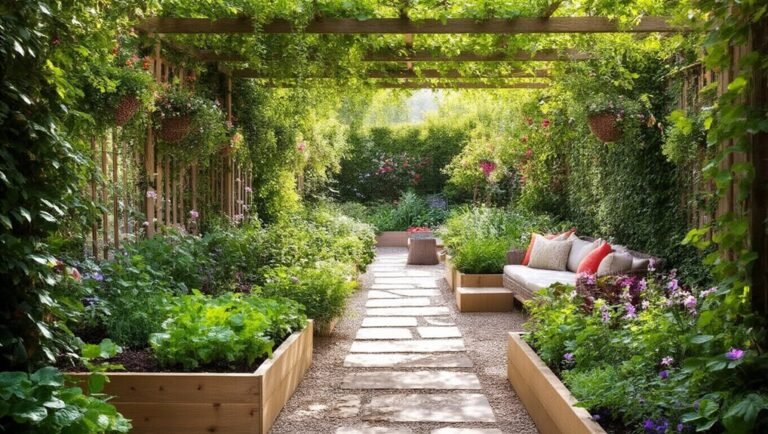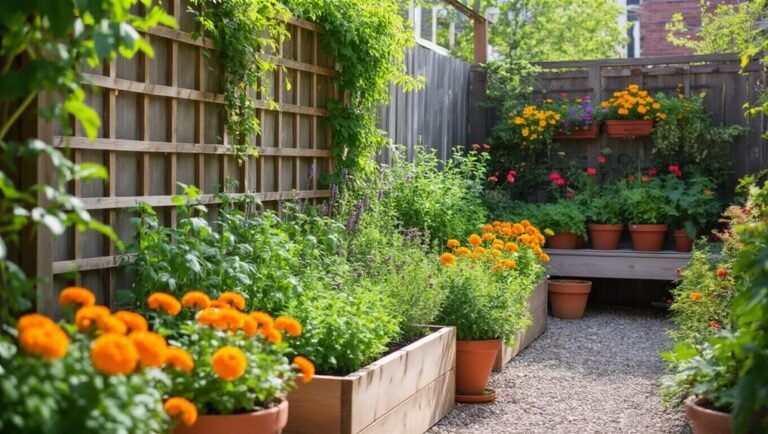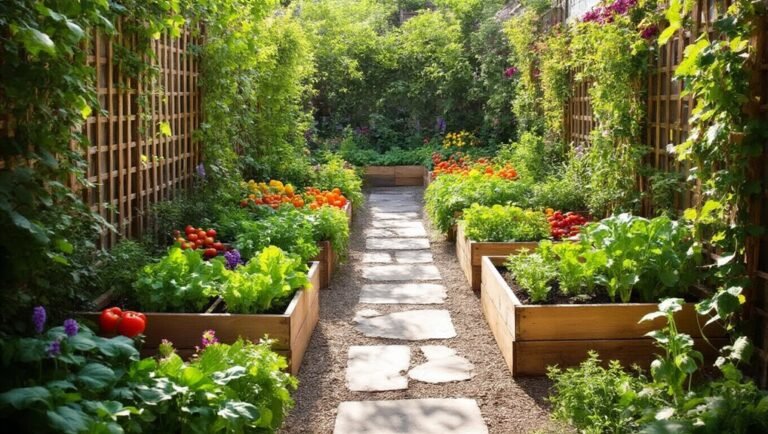To start your first vegetable garden, choose a spot that gets six to eight hours of sunlight daily and has good drainage. Test your soil’s pH and nutrients, and aim for loamy soil. Pick vegetables suited to your local climate and your favorite types for enjoyment. Carefully plan your garden layout, ensuring easy access for maintenance. Water regularly, apply mulch, and watch for pests. There’s much more to learn to create a thriving garden.
Key Takeaways
- Choose a sunny location that receives six to eight hours of sunlight daily and has good drainage.
- Test and improve your soil with high-quality garden soil and organic mulch for optimal growing conditions.
- Select easy-to-grow vegetables suited to your climate and available space, such as tomatoes and lettuce.
- Plan your garden layout by grouping plants with similar needs and ensuring easy access for maintenance.
- Water regularly, apply mulch, and monitor for pests to keep your garden healthy and thriving.
Choosing the Right Location
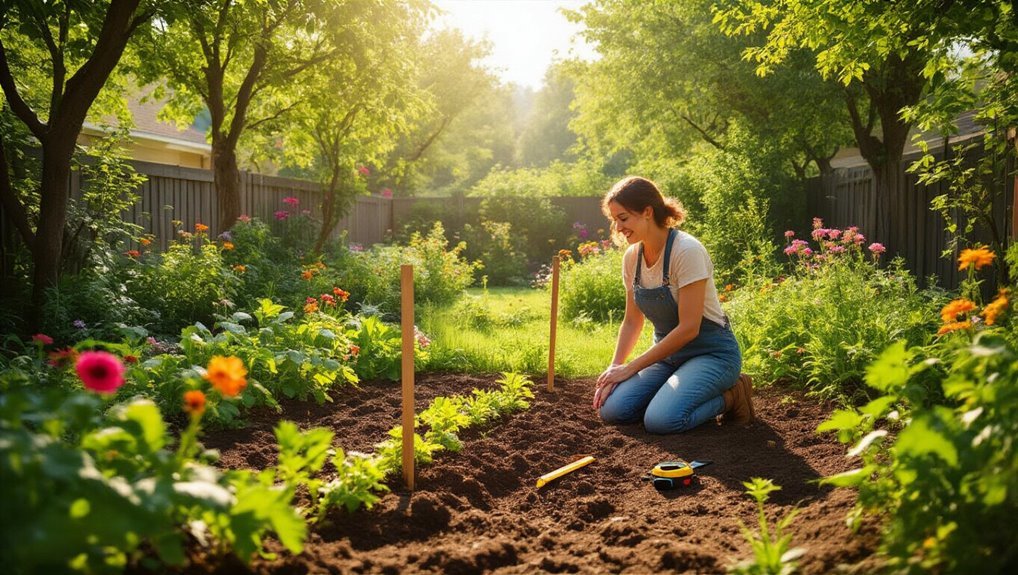
Choosing the right location for your vegetable garden is crucial to its success.
You’ll want to pick a spot that gets at least six to eight hours of sunlight daily. Full sun helps your plants thrive and produce delicious veggies.
Look for an area that’s easily accessible; you’ll be watering, weeding, and harvesting regularly. Consider how garden hoses can help make watering much more convenient in your chosen location.
Make sure the site has good drainage, as standing water can harm your plants.
Avoid spots near large trees or shrubs; they’ll compete for nutrients and water.
Lastly, consider the proximity to a water source to make your gardening tasks easier.
To make transporting soil, tools, and harvests more convenient, consider using garden carts in your setup.
By selecting the right location, you set the stage for a bountiful and productive vegetable garden.
Happy gardening!
Understanding Your Soil
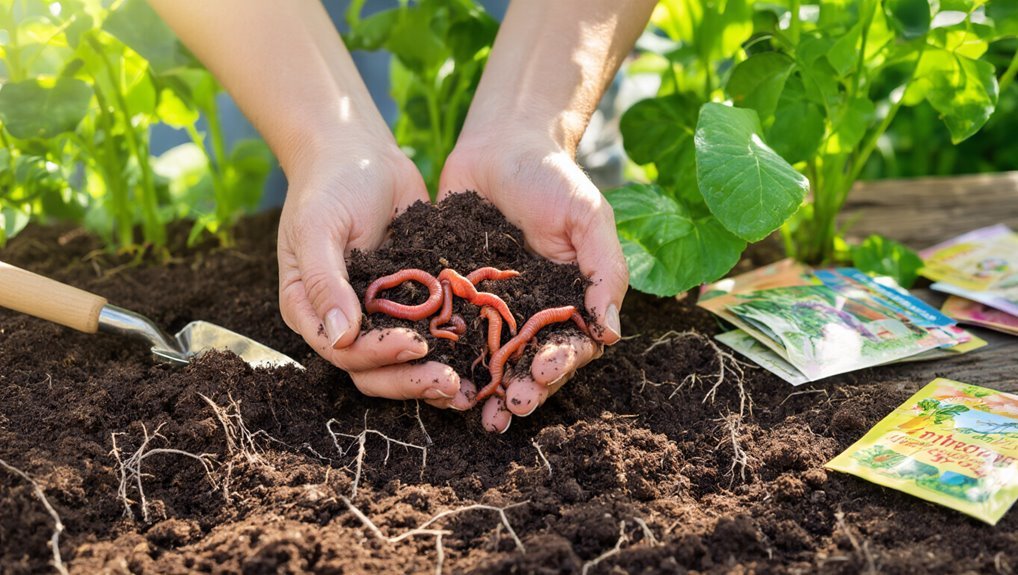
The foundation of a thriving vegetable garden lies in the quality of your soil. To grow healthy plants, you need to understand your soil’s composition and health. Start by testing your soil’s pH and nutrient levels. You can purchase a testing kit or send a sample to a local lab. For the best results, consider starting with the best garden soil to ensure your plants receive optimal nutrients and structure. Adding organic mulch to your garden beds can further improve soil health by retaining moisture, regulating temperature, and suppressing weeds.
Here’s a quick guide to soil types:
| Soil Type | Characteristics |
|---|---|
| Sandy | Drains quickly, low nutrients |
| Clay | Retains water, nutrient-rich |
| Loamy | Balanced, ideal for gardening |
| Silty | Holds moisture, fertile |
| Peaty | Acidic, retains moisture |
Selecting the Best Vegetables
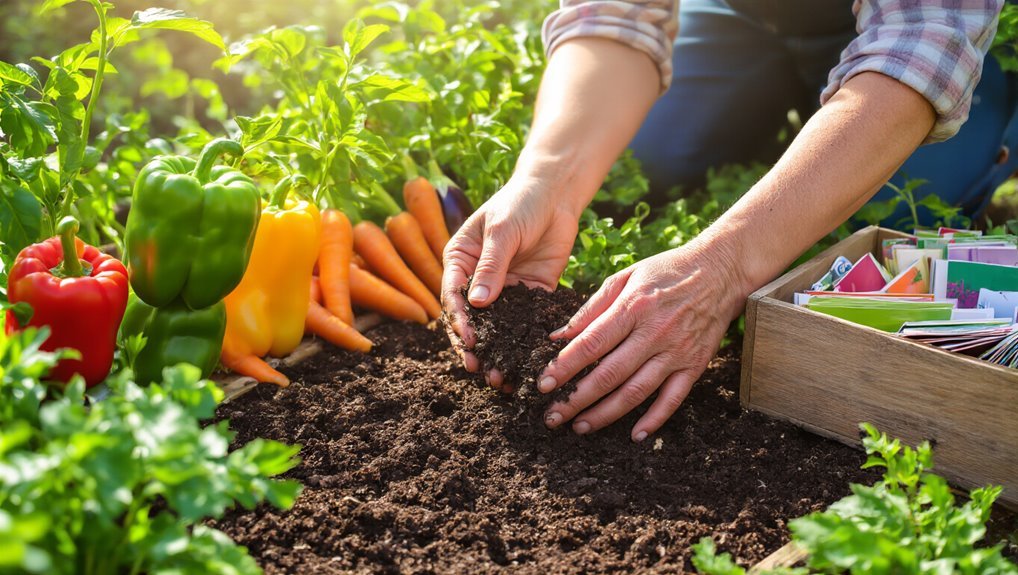
After assessing your soil, it’s time to think about the vegetables you want to grow. Choosing the right plants can make a big difference in your garden’s success. For the best results, many beginners find it helpful to use seed starting kits to give their vegetables a strong start indoors before transplanting them outside.
Consider these factors when selecting your vegetables:
- Climate: Pick veggies suited to your local climate and growing season.
- Space: Think about how much room you have; some plants require more space than others.
- Personal preference: Grow what you love to eat! This ensures you’ll enjoy tending to your garden.
Start with easy-to-grow varieties like tomatoes, radishes, and lettuce, which often yield quickly and boost your confidence. To help your vegetables thrive, consider using plant food options that provide essential nutrients for healthy growth.
Planning Your Garden Layout
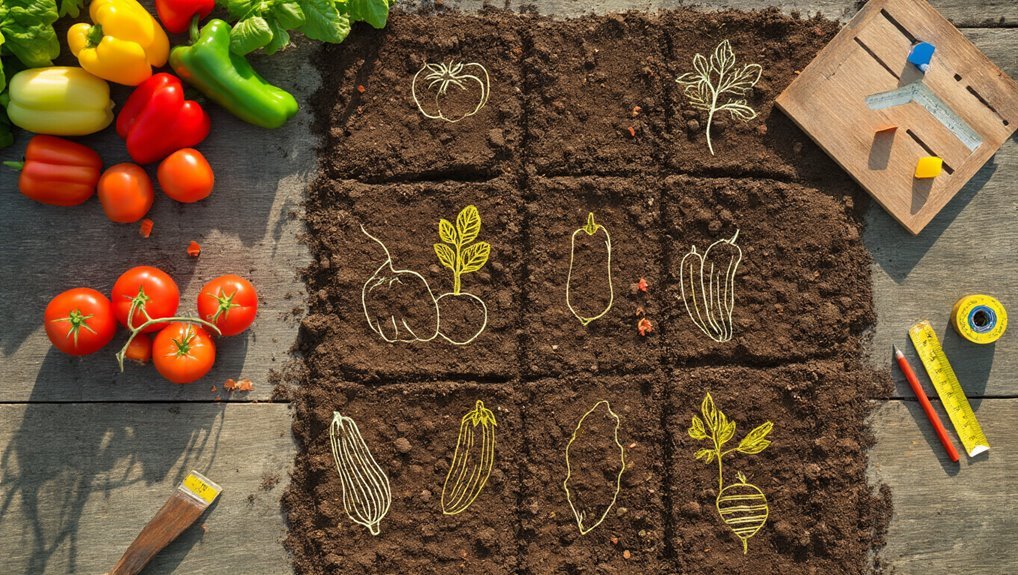
A well-thought-out garden layout can significantly enhance your gardening experience. Start by assessing your space, considering sunlight, wind patterns, and water access. When selecting your tools, it’s crucial to choose a garden trowel that fits comfortably in your hand and suits the type of soil you’ll be working with. Use a grid or raised beds to maximize efficiency and make maintenance easier. Group plants with similar needs together, which simplifies watering and care. Remember to leave pathways for easy access; you don’t want to trample your plants while tending to them.
Also, think about vertical gardening options for climbing vegetables, which can save space. Finally, sketch your design on paper or use gardening apps to visualize your layout.
This planning phase sets the foundation for a thriving garden, ensuring you’ll have a productive and enjoyable growing season. Incorporating raised garden beds can further elevate your gardening by improving soil quality, drainage, and accessibility.
Planting and Caring for Your Vegetables
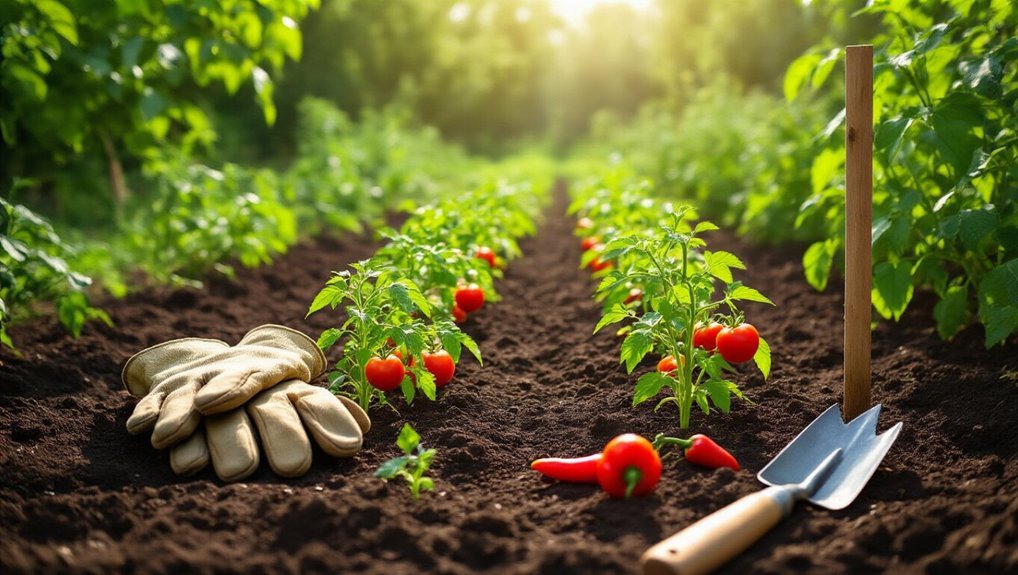
With your garden layout in place, it’s time to focus on planting and caring for your vegetables. Start by choosing the right time to plant, considering the specific needs of each vegetable.
Make sure to water your plants regularly, keeping the soil moist but not soggy. Here are some key tips to ensure your garden thrives:
- Mulch around plants to retain moisture and suppress weeds.
- Fertilize as needed to give your vegetables the nutrients they require.
- Watch for pests and diseases, addressing issues promptly to keep your plants healthy.
Harvesting and Enjoying Your Bounty
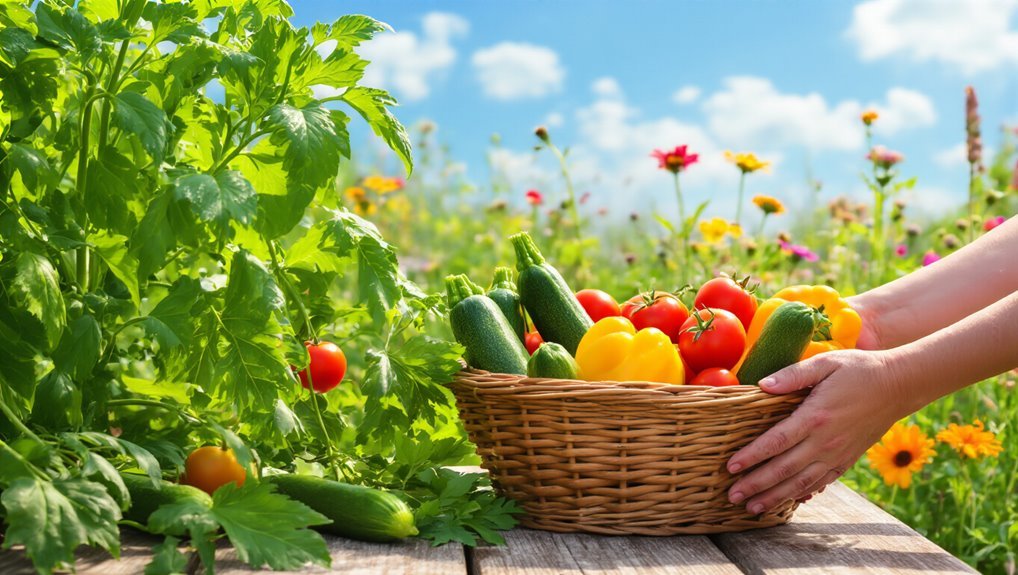
Once your vegetables are ripe and ready, it’s time to enjoy the fruits of your labor. Harvesting is simple—just pick your veggies when they’re at their peak flavor. Use a sharp knife or scissors to avoid damaging the plants. Remember to wash your harvest thoroughly before cooking or eating.
To help you plan your meals, here’s a quick reference for some common vegetables:
| Vegetable | Best Time to Harvest | Storage Tips |
|---|---|---|
| Tomatoes | When fully colored | Keep at room temp |
| Lettuce | When leaves are firm | Refrigerate in bags |
| Carrots | When size is right | Store in cool, dark |
| Peppers | When color is vibrant | Refrigerate |
| Zucchini | When small and firm | Store in fridge |
Enjoy experimenting with different recipes!
Frequently Asked Questions
How Much Time Should I Dedicate to My Vegetable Garden Weekly?
You’ll feel like a superhero with just a few hours each week! Dedicate around 3 to 5 hours, balancing planning, planting, watering, and weeding. Your garden will thrive, and so will your gardening skills!
What Tools Are Essential for Starting a Vegetable Garden?
You’ll need a few essential tools for your vegetable garden. Grab a spade, trowel, rake, and watering can. Don’t forget gloves and pruning shears—they’ll make your gardening experience easier and more enjoyable!
Can I Grow Vegetables in Containers Instead of the Ground?
Absolutely, you can grow vegetables in containers! Just choose the right size pots, use quality soil, and ensure they get enough sunlight. You’ll enjoy fresh produce even in limited space, making gardening accessible and fun.
How Do I Protect My Garden From Pests Naturally?
To protect your garden from pests naturally, you can introduce beneficial insects, use companion planting, and apply organic deterrents like neem oil. Regularly inspect your plants and remove any pests you find to keep them healthy.
What Are the Best Practices for Composting in My Garden?
Think of composting as nature’s recycling program. You’ll want to balance greens and browns, keep it moist, and turn it regularly. This’ll create rich soil, nourishing your plants and promoting a thriving garden ecosystem.
Conclusion
Starting your first vegetable garden is a satisfying step toward sustainable living. With careful consideration of location, soil, and selection, you’ll cultivate a colorful cornucopia of fresh flavors. As you plant, nurture, and harvest, you’ll not only enjoy delicious dishes but also develop a deeper connection to nature. So dig in, delight in the discovery, and let your green thumb grow! Your journey into gardening is just beginning, and the rewards are ripe for the picking.
